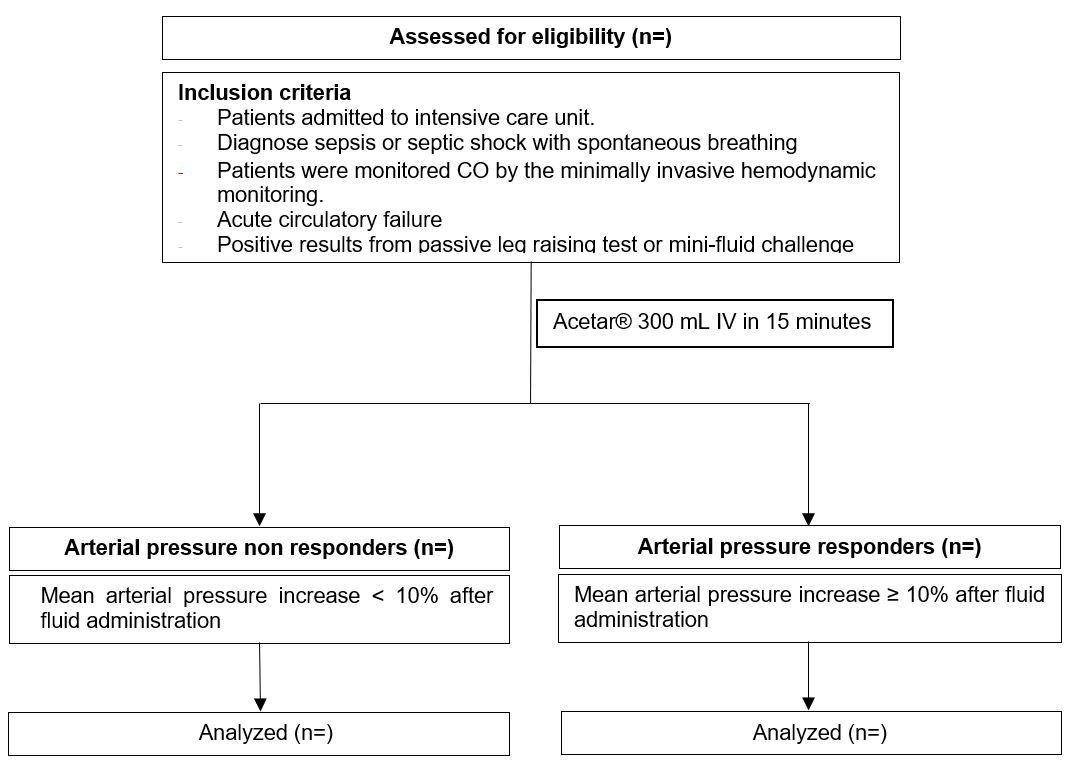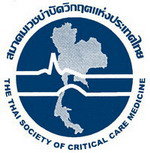Dynamic arterial elastance for predicting mean arterial pressure responsiveness after fluid challenge in spontaneously breathing septic patients: A protocol for prospective observational study
Dynamic arterial elastance in spontaneously breathing septic patients
DOI:
https://doi.org/10.54205/ccc.v31.260187Keywords:
Arterial pressure, Cardiac output, Fluid therapy, Hemodynamics, Stroke volumeAbstract
Background: Fluid resuscitation is essential for patients with sepsis and septic shock; however, the response of blood pressure to fluids is still challenging. Dynamic arterial elastance (Eadyn), defined as the ratio between pulse pressure variation (PPV) and stroke volume variation (SVV), is one of the parameters that has been proposed to predict mean arterial pressure (MAP) response to fluid administration. PPV and SVV are obtained from the heart-lung interaction concepts, in which spontaneous breathing is an important limitation. In this study, we evaluate the accuracy (sensitivity and specificity) of Eadyn in predicting the MAP response after fluid administration in predicted fluid responsive, spontaneously breathing septic patients.
Methods: Spontaneously breathing patients with sepsis or septic shock and acute circulatory failure who were predicted to be fluid responders by the passive leg raising test or the mini-fluid challenge test were enrolled. PPV, SVV, Eadyn and the other hemodynamic parameters were measured by an arterial catheter connected to FloTracTM sensor integrated with the HemoSphereTM platform before and after a fluid challenge. Patients were classified according to the increase in MAP after fluid administration into 2 groups: MAP-responders (MAP increase ≥ 10%) and MAP-nonresponders (MAP increase < 10%).
Hypothesis: In predicted fluid responders and spontaneously breathing septic patients, Eadyn should have predicted blood responsiveness.
Ethics and dissemination: The Ramathibodi Human Research Ethics Committee has approved the trial. The findings plan to be presented in peer-reviewed publications and conferences in critical care medicine.
Downloads
References
Evans L, Rhodes A, Alhazzani W, Antonelli M, Coopersmith CM, French C, et al. Surviving sepsis campaign: International guidelines for management of sepsis and septic shock 2021. Critical Care Medicine 2021;49:e1063-e143.
Sunagawa K, Maughan WL, Burkhoff D, Sagawa K. Left ventricular interaction with arterial load studied in isolated canine ventricle. Am J Physiol 1983;245:H773-80.
Pinsky MR. Protocolized cardiovascular management based on ventricular-arterial coupling. In: Pinsky MR, Payen D. (eds), editor. Functional hemodynamic monitoring. Update in Intensive Care and Emergency Medicine. Springer, Berlin, Heidelberg; 2005; 381-95.
Zhou X, Pan W, Chen B, Xu Z, Pan J. Predictive performance of dynamic arterial elastance for arterial pressure response to fluid expansion in mechanically ventilated hypotensive adults: a systematic review and meta-analysis of observational studies. Ann Intensive Care. 2021;11:119.
Monge García MI, Gil Cano A, Gracia Romero M. Dynamic arterial elastance to predict arterial pressure response to volume loading in preload-dependent patients. Crit Care. 2011;15:R15.
García MI, Romero MG, Cano AG, Aya HD, Rhodes A, Grounds RM, et al. Dynamic arterial elastance as a predictor of arterial pressure response to fluid administration: a validation study. Crit Care. 2014;18:626.
Seo H, Kong YG, Jin SJ, Chin JH, Kim HY, Lee YK, et al. Dynamic arterial elastance in predicting arterial pressure increase after fluid challenge during robot-assisted laparoscopic prostatectomy: A prospective observational study. Medicine (Baltimore). 2015;94:e1794.
Pinsky MR. Defining the boundaries of bedside pulse contour analysis: dynamic arterial elastance. Crit Care. 2011;15:120.
Cecconi M, Monge García MI, Gracia Romero M, Mellinghoff J, Caliandro F, Grounds RM, et al. The use of pulse pressure variation and stroke volume variation in spontaneously breathing patients to assess dynamic arterial elastance and to predict arterial pressure response to fluid administration. Anesth Analg. 2015;120:76-84.
Singer M, Deutschman CS, Seymour CW, Shankar-Hari M, Annane D, Bauer M, et al. The third international consensus definitions for sepsis and septic shock (sepsis-3). JAMA. 2016;315:801-10.
Cannesson M, Le Manach Y, Hofer CK, Goarin JP, Lehot JJ, Vallet B, et al. Assessing the diagnostic accuracy of pulse pressure variations for the prediction of fluid responsiveness: a "gray zone" approach. Anesthesiology. 2011;115:231-41.
Michard F, Boussat S, Chemla D, Anguel N, Mercat A, Lecarpentier Y, et al. Relation between respiratory changes in arterial pulse pressure and fluid responsiveness in septic patients with acute circulatory failure. Am J Respir Crit Care Med. 2000;162:134-8.
Marik PE, Cavallazzi R, Vasu T, Hirani A. Dynamic changes in arterial waveform derived variables and fluid responsiveness in mechanically ventilated patients: a systematic review of the literature. Crit Care Med. 2009;37:2642-7.
Yang X, Du B. Does pulse pressure variation predict fluid responsiveness in critically ill patients? A systematic review and meta-analysis. Crit Care. 2014;18:650.
Heenen S, De Backer D Fau - Vincent J-L, Vincent JL. How can the response to volume expansion in patients with spontaneous respiratory movements be predicted? Crit Care. 2006;10:R102.
Hong DM, Lee JM, Seo JH, Min JJ, Jeon Y, Bahk JH. Pulse pressure variation to predict fluid responsiveness in spontaneously breathing patients: tidal vs. forced inspiratory breathing. Anaesthesia. 2014;69:717-22.
Khwannimit B, Bhurayanontachai R. Prediction of fluid responsiveness in septic shock patients: comparing stroke volume variation by FloTrac/Vigileo and automated pulse pressure variation. Eur J Anaesthesiol. 2012;29:64-9.
Guarracino F, Bertini P, Pinsky MA-OX. Cardiovascular determinants of resuscitation from sepsis and septic shock. Crit Care. 2019;15:118.
Hadian M, Severyn Da Fau - Pinsky MR, Pinsky MR. The effects of vasoactive drugs on pulse pressure and stroke volume variation in postoperative ventilated patients. J Crit Care. 2011;26:328.e1-.e8.

Downloads
Published
How to Cite
Issue
Section
License
Copyright (c) 2023 The Thai Society of Critical Care Medicine

This work is licensed under a Creative Commons Attribution-NonCommercial 4.0 International License.




